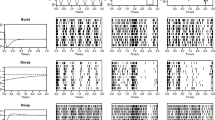Abstract.
A model of sensory learning is proposed that is based upon Hebb's rule, where Hebb's rule has been generalised by introducing a stabilising function representing some feedback process within or at the adapting (cortical) neuron, preventing synaptic weights from increasing without limit. It will be shown that neurons adapting according to this stabilised Hebb rule will turn into a matched filter for that part of the stimulus pattern that covers the receptive field of a neuron. It follows that the presentation of a stimulus pattern may imply the formation of a set of neurons with overlapping receptive fields, where each neuron has adapted to a certain part of the stimulus. Making simplifying assumptions about the detection process, the model will be illustrated, fitting it to data from Meinhardt and Mortensen [Meinhardt G, Mortensen U (1998) Biol Cybern 79:413–425] which are not compatible with the classical matched filter model introduced by Hauske et al. [Hauske G, Wolf W, Lupp U (1976) Biol Cybern 22:181–188].
Similar content being viewed by others
Additional information
Received: 10 May 1999 / Accepted in revised form: 22 October 1999
Rights and permissions
About this article
Cite this article
Mortensen, U., Nachtigall, C. Visual channels, Hebbian assemblies and the effect of Hebb's rule. Biol Cybern 82, 401–413 (2000). https://doi.org/10.1007/s004220050594
Issue Date:
DOI: https://doi.org/10.1007/s004220050594




